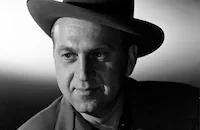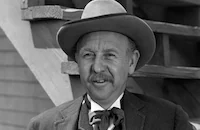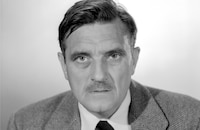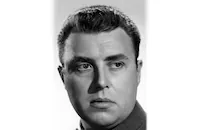Reunion in France

Brief Synopsis
Cast & Crew
Jules Dassin
Joan Crawford
John Wayne
Philip Dorn
Reginald Owen
Albert Bassermann
Film Details
Technical Specs

Synopsis
In the summer of 1939, Parisian socialite Michele de la Becque tries to encourage her lover, automotive designer Robert Cortot, to come with her to the South of France, but Robert refuses because of the war. The self-centered Michele does not understand and frivolously goes to her favorite couturier, Mme. Montanot, for a new wardrobe. As Michele leaves for her holiday, Robert tries to tell her how important France is to him and to make her understand what the war means, but she dismisses his words. Soon German forces cross France's seemingly impenetrable Maginot Line and Paris is occupied by the Nazis. Returning to Paris, Michele finally begins to realize the horrors of war. Her house is now occupied by the Nazis, but when she goes to Robert's, she is puzzled to find that his life has barely been affected by the war. That night, while they dine at an elegant hotel, Michele is revulsed to discover that Robert is a favorite of highly placed Nazis. When the concierge, Martin, an old friend, tells her of Robert's blatant collaboration, she refuses to occupy the luxurious room that Robert has arranged for her. After she leaves, Martin is arrested by Ulrich Windler, head of the Paris Gestapo. Back at Michele's house, in the small, exterior servant's quarters she now occupies, Robert is waiting and tries to reason with her, but she refuses his help and is disgusted by his pro-Nazi attitude. The next day she goes to Montanot to ask for a job. On the way home, she is accosted by a man who is running from the Nazis, downed RAF Eagle Squadron flyer Patrick Talbot, from Wilkes Barre, Pennsylvania. Although suspicious, she lets him in her room because they are being followed by Gestapo agent Stregel and French gendarme Durand. The next morning, after the exhausted Pat has had a good night's sleep, he offers to leave, but she tells him to stay and decides to help him. Unknown to her, the suspicious Stregel is still watching her place, and is relieved by an apparent superior, Herr Schultz. That day, the patriotic Montanot and her assistant Juliette agree to help Pat with money and forged papers. When Robert comes to the shop, he angrily warns Michele that her attitude will soon get her into trouble with the Nazis and begs her to let him help her to leave France. That night, as Michele and Pat flirt with each other, the German officer occupying her house drunkenly storms into her room. He exchanges barbs with Pat, who, as an American is not yet an enemy of Germany, but who incurs his wrath. To avoid a dangerous confrontation, Michele pretends she is attracted to the officer and distracts him until Juliette's boyfriend takes Pat safely away. Michele then goes to Robert to ask his help to leave France and says that she wants a car and would like to use an American student who has lost his papers as her chauffeur. He agrees to help and she promises to pretend to be his fiancée. One week later, Pat, who now poses as Michele's chauffeur, thinks that the reason she quit her job and now socializes with the Nazis she hates, is that she loves him and is trying to save him. When Schultz sees them talking in a familiar way, he secretly tells Robert. At a Parisian nightclub, Michele tries to charm Windler and General Hugo Schroeder, the prefect of Paris, but Windler is suspicious of her. Meanwhile, in a small hotel, two men tell Schultz that a photo of Pat confirms that he is the missing RAF flier and say that they must work quickly. Soon Honore, Robert's butler, brings Michele her papers, saying that she must leave immediately. Robert then comes to her, and after tenderly saying that he loves her and France more than ever, sends her away with Schultz. She is certain that Robert has betrayed her when she is put into a car with two men in Nazi uniforms. When they then drive to pick up Pat, he is put into another car, and she assumes that he is now a prisoner. The two cars arrive at a checkpoint at the same time and Michele realizes that Schultz and the other two "Nazis" are really British agents. The two cars speed off after Schultz creates a diversion. As the Nazis from the checkpoint chase the car in which Michele and Schultz are riding, he is mortally wounded, just before killing the pursuing Nazi commandant. Before sending Michele off toward a secret airfield, Schultz, whose real name is Pinkum, reveals that Robert is really a leader in the French underground. At the airfield, Pat and the others are waiting for a plane to take them to England. When it lands, Michele thinks about what Pinkum had told her about Robert. The next morning, in Paris, Schroeder and Windler arrive at Robert's house with news of Pat's escape and are about to arrest him for arranging it when Michele arrives. This is evidence enough to convince Schroeder that Robert is blameless and he and Windler leave. Waiting in the doorway as Schroeder and Windler drive off, Michele and Robert are hurt when some small children angrily call them traitors, but take courage from the knowledge that their cause is just.

Director

Jules Dassin
Cast

Joan Crawford

John Wayne

Philip Dorn

Reginald Owen

Albert Bassermann

John Carradine
Ann Ayars

J. Edward Bromberg

Moroni Olsen

Henry Daniell

Howard Da Silva

Charles Arnt

Morris Ankrum
Edith Evanson
Ernest Dorian
Margaret Laurence
Odette Myrtil

Peter Whitney
Arthur Space
Ira "buck" Woods
Ann Codee
Oliver B. Prickett

Charles Arnt
Natalie Schafer
Michael Visaroff
Felix Basch
Paul Weigel
John Considine
Rodney Bieber
Claudia Drake

Peter Leeds
Bobby Dillon
Barbara Bedford
Basil Bookasta

Henry Kolker
George Calliga
Harry Adams
Larry Grenier
Ed Rickard
Philip Van Zandt
Louis Mercier
Jean Del Val
Lester Sharpe
Hans Furberg
Otto Reichow
Frederick Brunn
Paul Kruger
David Clarke
Carl Ekberg
Adolph Milar
Ludwig Donath

Ava Gardner
William Edmunds
Arno Frey
Joel Friedkin
Wilda Bieber
Greta Keller
Walter O. Stahl
Doris Borodin
Jody Gilbert
Edgar Licho

Jacqueline White
Bob Stevenson
Hans Von Morhart
Crane Whitley
James Craven
Gayne Whitman
Kay Deslys
Sheldon Jett
Major Fred Farrell
Henry Rowland
George Aldwin
William Vaughn
Ray De Ravenne
Eddie Lee
Tommy Lee
Muriel Barr
Norma Thelan
Sandra Morgan
John Meredith
Martha Bamattre
Joe Bernard
Harry Semels
Lotte Palfi
Lisl Valetti
Stuart Hall
Alan Schute
Guy D'ennery
Jack Zoller
Hermine Sterler
Trude Berliner
Louise Colombet
Greta Meyer
Crew
Marvin Borowsky
Ladislas Bus-fekete
Daniel B. Cathcart
Marc Connelly
Charles Davenport
Cedric Gibbons
Stanley Goldsmith
Henry Grace
Charles Hoffman
Irene
Jan Lustig
Joseph L. Mankiewicz
Warren Newcombe
Robert Planck
Douglas Shearer
Elmo Veron
Franz Waxman
Edwin B. Willis

Photo Collections
Film Details
Technical Specs

Articles
Reunion in France
After the critical and commercial success of A Woman's Face (1941), Crawford hoped that her career at MGM was on the upswing. Although an immensely popular star at Metro since the 1920s, she was never taken very seriously as an actress and had to content herself with high-gloss melodramas and mostly tepid romantic comedies while the best roles at the studio went to the other queens of the lot, Greta Garbo and Norma Shearer. But under George Cukor's sympathetic and exacting direction, she was finally gaining some respect in such films as The Women (1939), Susan and God (1940) and A Woman's Face, in which she allowed her glamorous image to be challenged by a role requiring her to be a hardened, disfigured criminal for much of the story.
Armed with new confidence in her abilities, she lobbied heavily to be cast in prestige projects like Random Harvest (1942) and Madame Curie (1943). But a new era was dawning at MGM; Garbo, Shearer and Crawford were on their way out, making room for Judy Garland, Katharine Hepburn, Lana Turner and Greer Garson, Louis B. Mayer's new discovery, who ended up with the roles Crawford so desperately wanted.
"If you think I made poor films at MGM after A Woman's Face, you should have seen the ones I went on suspension not to make!" she later said. After Reunion in France, she made one more picture for the studio - another rather improbable wartime tale called Above Suspicion (1943) - then departed Metro for good after 18 years. She went to Warner Brothers, where she held out for two years until she got the kind of meaty role she'd been waiting for, her Oscar®-winning Mildred Pierce (1945).
Despite similarities (a love triangle set during the Nazi occupation and much ado about letters of transit), it has to be said this is no Casablanca (1942), although to be fair, it is a good example of the kind of propaganda film the studios were turning out in the early days of the war, with little worry about credibility. It does have some interesting and impressive credentials. As the pilot rescued by Crawford, budding star John Wayne made his second war film of the period (despite never seeing military service himself. for which he was later criticized). The producer was Joseph L. Mankiewicz, who in a few years would begin a directorial career that earned him Academy Awards for A Letter to Three Wives (1949) and All About Eve (1950). One reason Crawford agreed to make Reunion in France was because she was promised John Wayne as her co-star, an actor she had wanted to meet for some time. According to biographers Lawrence J. Quirk and William Schoell in Joan Crawford: The Essential Biography (University Press of Kentucky), "...Joan was on the prowl for John Wayne...She made her move on him in the dressing room, and Wayne rebuffed her with as much charm as he could muster. He was married and in no mood for a dalliance. Joan didn't take no for an answer so easily, and she threw herself at him more than once...Wayne was more amused than angry by it all. Even in later years Joan would fume about the man who got away and the terrible picture she made because she'd been so hot for him. 'That lousy movie! Just because I wanted to get Wayne in the sack! And the only thing he could play was cowboys. We hit it off like filet mignon and ketchup!'"
Crawford's co-star in Reunion in France, Natalie Schafer, recalled Joan's mood on the set once filming began (in Joan Crawford: The Essential Biography): "I think Joan was about at the end of her rope. She wasn't brutal or offensive to me or to anyone else - just tightly wound. I think she knew her days were numbered at MGM, she was smarting over the assignments they had given her. Reunion in France was not right for her and she just did not want to be [on the set]. But she remained very professional in spite of all that. That was Joan. Whatever was going on in her mind, you might see glimmers of it in her expression, in her off-camera mood, but she was always about getting the work done, being a pro."
Reunion in France was the fourth feature directed by Jules Dassin, who later made several acclaimed films noir, among them Brute Force (1947), The Naked City (1948) and Night and the City (1950), and brought his wife, Melina Mercouri, to international attention in Never on Sunday (1960). One of the screenwriters was Marc Connelly, Pulitzer Prize-winner for his 1930 play The Green Pastures. The large cast boasts a number of noted character actors, including John Carradine, Crawford's later supporting player in Johnny Guitar (1954), as well as an early (uncredited) appearance by the young Ava Gardner. But this being a Crawford film, the real star of the picture was the costumes created by Irene. The star's many sumptuous gowns got the most attention in reviews, with the New York Herald Tribune noting: "Dressing like a refugee is certainly not in her contract."
During this low point in her life and career, Joan Crawford hastily entered into her third (or fourth, depending on the source) marriage with a young actor, Phillip Terry, who had played a very brief bit part in her movie Mannequin (1937). The marriage lasted less than four years. John Wayne recalled Crawford's arrival at the studio during production of Reunion in France the morning after they were wed: "I knew what kind of marriage it was going to be when I saw her walk on the set. First came Joan, then her secretary, then her makeup man, then her wardrobe woman, finally Phil Terry, carrying the dog." Crawford herself later admitted her fault in the failure of the relationship: "I married because I was unutterably lonely. ... I've owed him an apology from the first."
Director: Jules Dassin
Producer: Joseph L. Mankiewicz
Screenplay: Jan Lustig, Marvin Borowsky, Marc Connelly
Cinematography: Robert Planck
Editing: Elmo Veron
Art Direction: Cedric Gibbons
Original Music: Franz Waxman
Cast: Joan Crawford (Michele de la Becque), John Wayne (Pat Talbot), Philip Dorn (Robert Cortot), Reginald Owen (Schultz), Moroni Olsen (Paul Grebeau), Henry Daniell (Emil Fleuron).
BW-99m. Closed captioning.
by Rob Nixon

Reunion in France
Jules Dassin (1911-2008) - TCM Schedule Change for Director Jules Dassin Memorial Tribute on Friday, April 20th
Sunday, April 20th
8:00 PM Naked City
9:45 PM Topkapi
TCM REMEMBERS JULES DASSIN (1911-2008)
Jules Dassin gained experience in theater and radio in New York before going to work in Hollywood in 1940, first with RKO (as assistant director) and then with MGM. Dassin hit his stride in the late 1940s with such dynamic (and still well-regarded) film noir melodramas as "Brute Force" (1947), "The Naked City" (1948), "Thieves' Highway" (1949) and "Night and the City" (1950), starring Richard Widmark who died this past Monday, March 24th.
After being blacklisted he moved to Europe, where he scored his greatest international successes with the French-produced "Rififi" (1955) and the then-scandalous "Never on Sunday" (1959), starring his second wife Melina Mercouri. For the most part, his later films--such as "Up Tight" (1968), an ill-conceived black remake of John Ford's 1935 classic "The Informer"--have been disappointing and inconclusive. Dassin, however, maintained that among his own films, his personal preference was "He Who Must Die" (1958), starring his wife Melina Mercouri. It is one of his least known films and is rarely screened today but here is a description of it: "Greece, in the 1920's, is occupied by the Turks. The country is in turmoil with entire villages uprooted. The site of the movie is a Greek village that conducts a passion play each year. The leading citizens of the town, under the auspices of the Patriarch, choose those that will play the parts in the Passion. A stuttering shepherd is chosen to play Jesus. The town butcher (who wanted to be Jesus) is chosen as Judas. The town prostitute is chosen as Mary Magdalene. The rest of the disciples are also chosen. As the movie unfolds, the Passion Play becomes a reality. A group of villagers, uprooted by the war and impoverished, arrive at the village led by their priest. The wealthier citizens of the town want nothing with these people and manipulate a massacre. In the context of the 1920's each of the characters plays out their biblical role in actuality."
Family
DAUGHTER: Julie Dassin. Actor. Mother, Beatrice Launer.
SON: Joey Dassin. Mother, Beatrice Launer.
SON: Rickey Dassin. Mother, Beatrice Launer.
Companion
WIFE: Beatrice Launer. Former concert violinist. Married in 1933; divorced in 1962.
WIFE: Melina Mercouri. Actor, politician. Born c. 1923; Greek; together from 1959; married from 1966 until her death on March 6, 1994.
Milestone
1936: First role on New York stage (Yiddish Theater)
1940: First film as assistant director Directed first stage play, "The Medicine Show 1941: Directed first short film, "The Tell-Tale Heart"
1942: Feature directing debut, "Nazi Agent/Salute to Courage"
Jules Dassin (1911-2008) - TCM Schedule Change for Director Jules Dassin Memorial Tribute on Friday, April 20th
Quotes
Trivia
Notes
The working title of the film was Reunion, the title under which it was copyrighted and under which trade publications reviewed it. According to a December 14, 1942 Hollywood Reporter news item, the title was changed to Reunion in France and the release date was moved up to Christmas 1942 to capitalize on an increased "national interest" in recent events in France. Pre-production news items in Hollywood Reporter noted that Paramount star Alan Ladd was originally sought for the film's "romantic" lead, presumably for the role taken over by John Wayne, and that Agnes Moorehead was being sought for an unspecified role. Hollywood Reporter production charts include Keenan Wynn in the cast, but he was not in the released film. Hans Conried was mentioned in a July 13, 1942 Hollywood Reporter news item as being cast in the film, but he was not in the released film. Other actors mentioned in various news items whose appearance in the film has not been confirmed include Christine Seward and Bert Hicks. The film marked the motion picture debut of Broadway actress Margaret Laurence and the first M-G-M assignment of costume designer Irene.

Miscellaneous Notes
Released in United States 1942
Released in United States 1942














